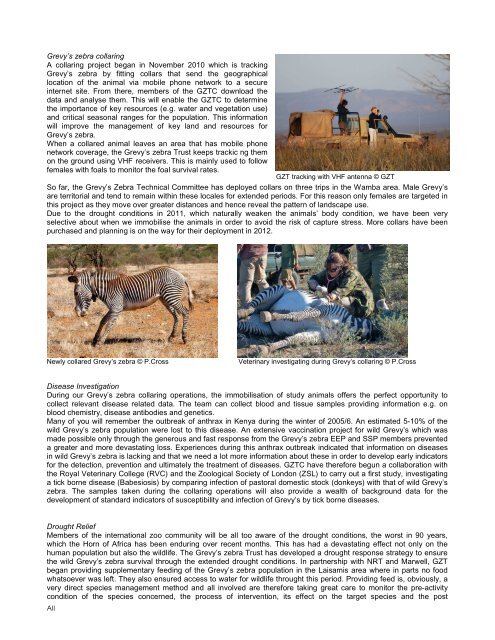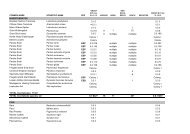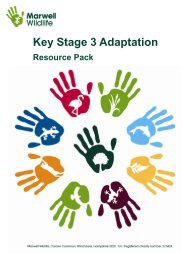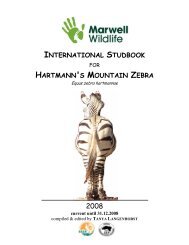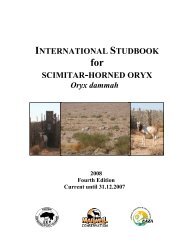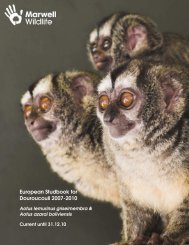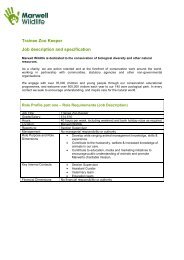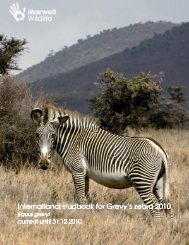International International studbook for Grevy's zebra ... - Marwell Zoo
International International studbook for Grevy's zebra ... - Marwell Zoo
International International studbook for Grevy's zebra ... - Marwell Zoo
Create successful ePaper yourself
Turn your PDF publications into a flip-book with our unique Google optimized e-Paper software.
Grevy’s <strong>zebra</strong> collaring<br />
A collaring project began in November 2010 which is tracking<br />
Grevy’s <strong>zebra</strong> by fitting collars that send the geographical<br />
location of the animal via mobile phone network to a secure<br />
internet site. From there, members of the GZTC download the<br />
data and analyse them. This will enable the GZTC to determine<br />
the importance of key resources (e.g. water and vegetation use)<br />
and critical seasonal ranges <strong>for</strong> the population. This in<strong>for</strong>mation<br />
will improve the management of key land and resources <strong>for</strong><br />
Grevy’s <strong>zebra</strong>.<br />
When a collared animal leaves an area that has mobile phone<br />
network coverage, the Grevy’s <strong>zebra</strong> Trust keeps trackic ng them<br />
on the ground using VHF receivers. This is mainly used to follow<br />
females with foals to monitor the foal survival rates.<br />
So far, the Grevy’s Zebra Technical Committee has deployed collars on three trips in the Wamba area. Male Grevy’s<br />
are territorial and tend to remain within these locales <strong>for</strong> extended periods. For this reason only females are targeted in<br />
this project as they move over greater distances and hence reveal the pattern of landscape use.<br />
Due to the drought conditions in 2011, which naturally weaken the animals’ body condition, we have been very<br />
selective about when we immobilise the animals in order to avoid the risk of capture stress. More collars have been<br />
purchased and planning is on the way <strong>for</strong> their deployment in 2012.<br />
Newly collared Grevy’s <strong>zebra</strong> © P.Cross Veterinary investigating during Grevy’s collaring © P.Cross<br />
Disease Investigation<br />
During our Grevy’s <strong>zebra</strong> collaring operations, the immobilisation of study animals offers the perfect opportunity to<br />
collect relevant disease related data. The team can collect blood and tissue samples providing in<strong>for</strong>mation e.g. on<br />
blood chemistry, disease antibodies and genetics.<br />
Many of you will remember the outbreak of anthrax in Kenya during the winter of 2005/6. An estimated 5-10% of the<br />
wild Grevy’s <strong>zebra</strong> population were lost to this disease. An extensive vaccination project <strong>for</strong> wild Grevy’s which was<br />
made possible only through the generous and fast response from the Grevy’s <strong>zebra</strong> EEP and SSP members prevented<br />
a greater and more devastating loss. Experiences during this anthrax outbreak indicated that in<strong>for</strong>mation on diseases<br />
in wild Grevy’s <strong>zebra</strong> is lacking and that we need a lot more in<strong>for</strong>mation about these in order to develop early indicators<br />
<strong>for</strong> the detection, prevention and ultimately the treatment of diseases. GZTC have there<strong>for</strong>e begun a collaboration with<br />
the Royal Veterinary College (RVC) and the <strong>Zoo</strong>logical Society of London (ZSL) to carry out a first study, investigating<br />
a tick borne disease (Babesiosis) by comparing infection of pastoral domestic stock (donkeys) with that of wild Grevy’s<br />
<strong>zebra</strong>. The samples taken during the collaring operations will also provide a wealth of background data <strong>for</strong> the<br />
development of standard indicators of susceptibility and infection of Grevy’s by tick borne diseases.<br />
Drought Relief<br />
Members of the international zoo community will be all too aware of the drought conditions, the worst in 90 years,<br />
which the Horn of Africa has been enduring over recent months. This has had a devastating effect not only on the<br />
human population but also the wildlife. The Grevy’s <strong>zebra</strong> Trust has developed a drought response strategy to ensure<br />
the wild Grevy’s <strong>zebra</strong> survival through the extended drought conditions. In partnership with NRT and <strong>Marwell</strong>, GZT<br />
began providing supplementary feeding of the Grevy’s <strong>zebra</strong> population in the Laisamis area where in parts no food<br />
whatsoever was left. They also ensured access to water <strong>for</strong> wildlife throught this period. Providing feed is, obviously, a<br />
very direct species management method and all involved are there<strong>for</strong>e taking great care to monitor the pre-activity<br />
condition of the species concerned, the process of intervention, its effect on the target species and the post<br />
AII<br />
GZT tracking with VHF antenna © GZT


